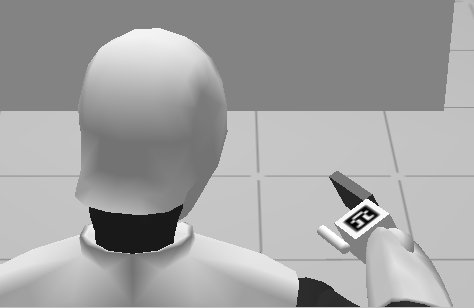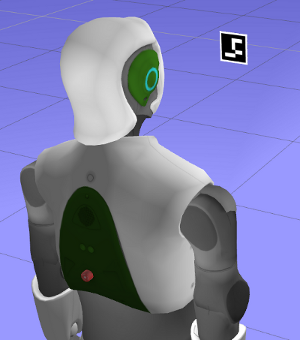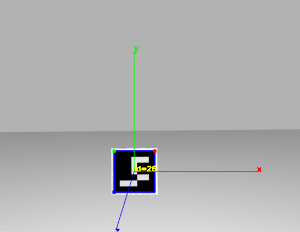aruco_ros
Software package and ROS wrappers of the Aruco Augmented Reality marker detector library.
Features
-
High-framerate tracking of AR markers
-
Generate AR markers with given size and optimized for minimal perceptive ambiguity (when there are more markers to track)
-
Enhanced precision tracking by using boards of markers
-
ROS wrappers
Applications
- Object pose estimation
- Visual servoing: track object and hand at the same time
ROS API
Messages
-
aruco_ros/Marker.msg
Header header uint32 id geometry_msgs/PoseWithCovariance pose float64 confidence -
aruco_ros/MarkerArray.msg
Header header aruco_ros/Marker[] markers
Kinetic changes
-
Updated the Aruco library to version 3.0.4
-
Changed the coordinate system to match the library's, the convention is shown in the image below, following rviz conventions, X is red, Y is green and Z is blue.
Test it with REEM
-
Open a REEM in simulation with a marker floating in front of the robot. This will start the stereo cameras of the robot too. Since this is only a vision test, there is nothing else in this world apart from the robot and a marker floating in front of it. An extra light source had to be added to compensate for the default darkness.
roslaunch reem_gazebo reem_gazebo.launch world:=floating_marker -
Launch the
image_procnode to get undistorted images from the cameras of the robot.ROS_NAMESPACE=/stereo/right rosrun image_proc image_proc image_raw:=image -
Start the
singlenode which will start tracking the specified marker and will publish its pose in the camera frameroslaunch aruco_ros single.launch markerId:=26 markerSize:=0.08 eye:="right"the frame in which the pose is refered to can be chosen with the 'ref_frame' argument. The next example forces the marker pose to be published with respect to the robot base_link frame:
roslaunch aruco_ros single.launch markerId:=26 markerSize:=0.08 eye:="right" ref_frame:=/base_link -
Visualize the result
rosrun image_view image_view image:=/aruco_single/result



